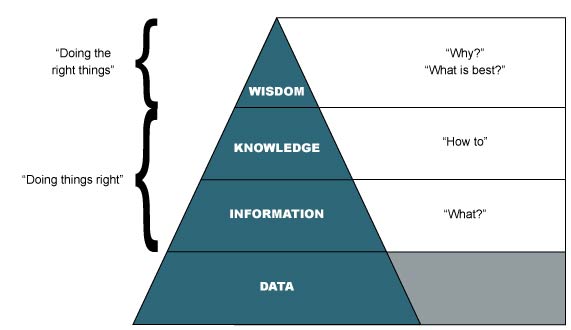
Ecommerce in the United States has grown to a $414 billion market, according to recent research conducted by Forrester. Clearly, this represents a huge opportunity for retail businesses but it signals a growing challenge as well. With each new dollar spent online, ecommerce businesses are collecting more customer data—and understanding and communicating this data will be critical for future success.
But making use of raw data is not easy. Filtering the significant trends from the noise requires skilled analysts, capable of communicating the story of this data across an organization. And beyond a story, reports must include actionable instructions tailored to the audience.

The problem is hardly new. In fact it has been codified as a model, best known as the Data-Information-Knowledge-Wisdom (DIKW) Pyramid described by management and organizational theorist Russell Ackoff in the 1980s. Data, which forms the base of the pyramid, is understood to be discrete facts or observations in an unorganized or unprocessed form. Information is inferred from data, transforming that foundational resource in order to answer basic questions. Knowledge is created when information is applied or put into action. Wisdom adds value to knowledge, extending it to inform sound judgments and guide decisions. The abstraction of the pyramid is useful for understanding that these levels of understanding build upon one another.
Put in more practical terms, information describes “what,” knowledge explains “how to.” Wisdom, on the other hand, describes “why” and “what is best.” Taken as a group, the former categories could be classified as “doing things right,” while wisdom is classified as “doing the right things”—but more important is the realization that different roles require different levels of detail and direction.
READ MORE: Communicating Testing Success Across Organizations
This is important for analysts and testing program managers looking to communicate results across an organization. Drawing on the DIKW model, it’s possible to describe three types of knowledge sharing that can be used as guidelines:
1. Report Information Across Testing Teams
For teams buried deep in the testing process, reporting complete information is important to maintain alignment and coordination. At this level, knowing what is happening across testing teams is critical to develop iterative ideas, avoid conflicts or collisions, and share learnings. Applied information is always helpful, but those developing, launching, and analyzing tests are comfortable and familiar with putting information into action.
2. Communicate Knowledge to Managers
When communicating results and reports with marketing, merchandising, product, or customer service managers, it’s important to illustrate the ways in which testing information can be applied. These reports will be shorter than those shared within testing teams, and focused on specific ways knowledge can be used to improve performance in these domains.
3. Share Wisdom with Executives
For executives, it is important to provide brief overviews of what is happening and how it is applied—but ultimately, this group is most concerned with understanding why certain behaviors have emerged, why tests have won or lost, and how efforts from teams have helped to increase performance. Perhaps more importantly, this group wants to know what the best course of action will be going forward. Distilling all that data, information, and knowledge into a single sheet of wisdom isn’t easy, but it ensures the hard work done by analysts is read, understood, and appreciated.
Communicating complex information and knowledge to different audiences is difficult. But by understanding the needs of each group and tailoring the story for them, analysts can increase the impact and value of their messages.
—
Brooks Bell helps top brands profit from A/B testing, through end-to-end testing, personalization, and optimization services. We work with clients to effectively leverage data, creating a better understanding of customer segments and leading to more relevant digital customer experiences while maximizing ROI for optimization programs. Find out more about our services.










